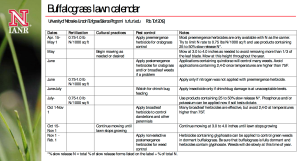While it’s true that proper turf management is the best frontline defense against the encroachment of weeds, for many folks, getting weeds in the lawn under control can feel like an uphill battle. Thankfully, there are a number of things you can do to thwart even the toughest invasive weeds.

An example of the free electronic (Adobe PDF) documents available from the University of Nebraska-Lincoln Turfgrass Sciences program.
Weed Control Education & Resources
Education is the first step in getting new or established weeds under control. The ability to identify problem weeds and understand their life cycle is important to knowing the best approach to take to eliminate them. A couple of resources that can be helpful in identifying the prevalent weeds in your area are your local extension office, or nearest University. Local lawn and garden stores can also be a valuable local knowledge base.
Here in our home state, the statewide extension is run through the University of Nebraska, which also has a world-class turfgrass science program located at its Lincoln campus. The publications and calendars available on Nebraska Extension website can help a Nebraska home or acreage owner, or landscape professional understand not just what to do, but when to do it based on the plant(s) you’re trying to kill.

This calendar for Buffalograss in Nebraska details the proper timing for fertilization, cultural practices (such as mowing) and pest control.
Weed Control Practices
Weed control practices are typically broken into physical or cultural practices, such as mowing, hoeing, mulching or overseeding, or using chemical herbicides, which kill the weeds on which they are applied.
Cultural practices are almost always a part of effective weed control.
According to Josh Friell, Ph. D, of The Toro Company’s Center for Advanced Turf Technology, there are a number of techniques that reduce weeds’ ability to gain a foothold on your lawn.
“Properly managing your turf will minimize any weed encroachment issues. The old saying goes, ‘weeds don’t cause poor turf, poor turf causes weeds’.
“You can maximize turf density with a sound fertilization program, and reduce weeds’ ability to germinate with simple things such as raising your mower cutting height. Your bagged clippings are also a great tool for crowding out weeds in flower beds.”
For lawn care professionals and homeowners alike, herbicides are often a part of the weed control equation. There are two reasons for this: speed and effectiveness at killing even established weeds.
For a number of common annual weeds including crabgrass and foxtail, spring is a good time to get the upper hand using a pre-emergent herbicide. Here in Nebraska, the window for pre-emergent application is typically late-April through early-May.
The timing of your application window will vary based on your location, as it’s determined by the soil temperature, which needs to be around 55 degrees for crabgrass germination. Other weeds germinate at slightly different temperatures, but the goal is the same: to kill weeds or inhibit germination right as they begin to germinate. Your local extension office can help you understand your window for pre-emergent application.
Fall is also an excellent time to focus on controlling problem weeds, as herbicides are very effective at getting at the roots of many problem weeds during this time. That said, not all weeds are appropriate to target in the fall.
“For example,” Friell says, “it can be quite quite wasteful to treat for annual weeds in the fall when they’ll be dead soon anyway.
“Remember, effective control is a matter of knowledge of the species. Use all of the resources at your disposal to understand the weeds life cycle and the best timing for achieving effective control.”
He says label guidance on the product being applied can be valuable for determining application rates and timing for specific weeds.
References and Information Sources:
- National Pesticide Information Center, County Extension Offices, http://npic.orst.edu/pest/countyext.htm
- Nebraska Extension in Lancaster County, Weed Control in Landscape & Gardens, http://lancaster.unl.edu/hort/articles/2013/WeedsLandscapeGarden.shtml
- University of Nebraska Turfgrass Sciences Program, Buffalograss Lawn Calendar, http://turf.unl.edu/NebGuides/buffalograsscalendar.pdf
- Nebraska Extension in Lancaster County, Spring Maintenance Techniques for a Healthy Lawn, http://lancaster.unl.edu/hort/articles/2005/plantlawn.shtml
- Nebraska Extension in Lancaster County, Fall Weed Control, http://lancaster.unl.edu/hort/articles/2013/FallWeedControl.shtml
- Mother Earth News, Practical Weed Control, http://www.motherearthnews.com/print.aspx?id={9FADC25C-AEC2-4EEC-88C5-53F3C7153FA1}
- The Old Farmer’s Almanac, Weed Control Techniques, http://www.almanac.com/content/weed-control-techniques
SHARE






